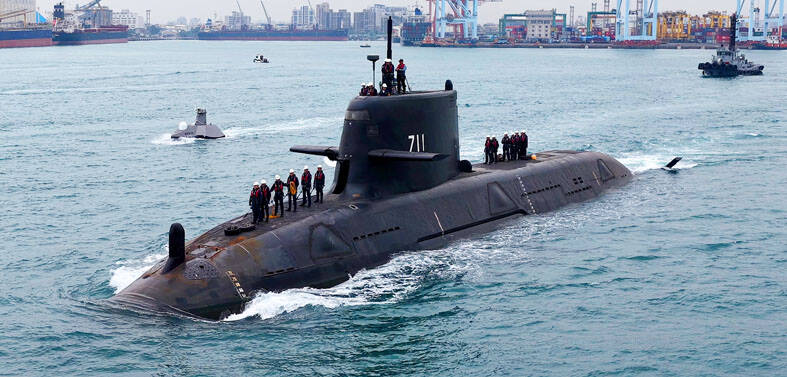Plans by the Ministry of National Defense (MND) to purchase 60 45-tonne missile boats to bolster anti-ship missile coverage and increase missile deployment mobility might be too idealistic and require reconsideration, legislators and defense analysts said on Wednesday last week.
The attack boats might be too light to offer a stable platform for the Hsiung Feng II anti-ship missiles, Democratic Progressive Party Legislator Tsai Shih-ying (蔡適應) said.
The small size of the ships would bar the possibility of installing anything but the most basic of radar systems, if their installation were even possible, which would greatly affect missile capability, Tsai said.
While the ministry’s assessments determined that the attack boats would be able to conduct missions in conditions up to level 5 winds on the Beaufort scale, wind speeds and waves during the winter often exceed level 5, Tsai said, adding that the proposed missile boats would be largely limited by such factors.
The Kuang Hua VI fast-attack missile boat serves the same purpose and acts as a more stable platform for launching missiles, Tsai said.
The ministry might want to revise its thinking about the viability of its proposal, Tsai said.
While the ministry should be applauded for seeking to make breakthroughs in asymmetrical warfare tactics, 45 tonnes is simply too light for a missile attack boat, Asia-Pacific Defense Magazine editor-in-chief Kevin Cheng (鄭繼文) said.
The ships could not provide the fire control and radar capacity required for such a platform, Cheng said.
The ships would simply become mobile missile platforms dependent on land-based radar guidance, Chen said, but added that were hostilities to break out across the Taiwan Strait, Taiwanese radar systems would undoubtedly be priority targets.
With its radars down, Taiwan’s traffic control and reconnaissance would be paralyzed, Cheng said, questioning whether the patrol boats’ intended wolf pack tactics would remain viable.
The ministry pursued similar tactics in 1980 when it created the Hai Ou missile boat — the Kuang Hua VI’s predecessor — Cheng said, adding that the Hai Ou was incapable of operating during the winter with winds greater than level 5.
China is also looking into asymmetrical warfare and plans to counter the nation’s wolf pack tactics with swarm tactics that use large fleets of uncrewed aerial vehicles (UAVs), Cheng said.
Whether Taiwanese wolf packs could perform surface guerilla warfare under bombardments by Chinese UAVs is unknown, he said.
The ministry might wish to consider laying mines, Cheng said, adding that they cost less and that China has relatively weak mine-sweeping and mine-hunting capabilities.
If Taiwan could successfully negotiate obtaining key technologies, such as combat systems, it would be one step closer to achieving its indigenous submarine project, Cheng added.

NUMBERS IMBALANCE: More than 4 million Taiwanese have visited China this year, while only about half a million Chinese have visited here Beijing has yet to respond to Taiwan’s requests for negotiation over matters related to the recovery of cross-strait tourism, the Tourism Administration said yesterday. Taiwan’s tourism authority issued the statement after Chinese-language daily the China Times reported yesterday that the government’s policy of banning group tours to China does not stop Taiwanese from visiting the country. As of October, more than 4.2 million had traveled to China this year, exceeding last year. Beijing estimated the number of Taiwanese tourists in China could reach 4.5 million this year. By contrast, only 500,000 Chinese tourists are expected in Taiwan, the report said. The report

Temperatures are forecast to drop steadily as a continental cold air mass moves across Taiwan, with some areas also likely to see heavy rainfall, the Central Weather Administration (CWA) said. From today through early tomorrow, a cold air mass would keep temperatures low across central and northern Taiwan, and the eastern half of Taiwan proper, with isolated brief showers forecast along Keelung’s north coast, Taipei and New Taipei City’s mountainous areas and eastern Taiwan, it said. Lows of 11°C to 15°C are forecast in central and northern Taiwan, Yilan County, and the outlying Kinmen and Lienchiang (Matsu) counties, and 14°C to 17°C

STEERING FAILURE: The first boat of its class is experiencing teething issues as it readies for acceptance by the navy, according to a recent story about rudder failure The Hai Kun (海鯤), the nation’s first locally built submarine, allegedly suffered a total failure of stern hydraulic systems during the second round of sea acceptance trials on June 26, and sailors were forced to manually operate the X-rudder to turn the submarine and return to port, news Web site Mirror Daily reported yesterday. The report said that tugboats following the Hai Kun assisted the submarine in avoiding collisions with other ships due to the X-rudder malfunctioning. At the time of the report, the submarine had completed its trials and was scheduled to begin diving and surfacing tests in shallow areas. The X-rudder,

DEMAND: The government should enact regulations in line with Austria and Germany to incorporate vegan nutrition into school meals, an advocate said More than 1,000 people yesterday marched in Taipei to promote veganism, calling for legislation to incorporate vegan diets into school lunches and the national net zero emissions program. Participants gathered on Ketagalan Boulevard in front of the Presidential Office Building for the march, which was organized by the Vegan Action Network (VAN). Former ambassador to Chad Chiu Chung-jen (邱仲仁), actor Yankee Yang (楊子儀) and actress Cindy Lien (連俞涵) attended the event. VAN member Marianne Chao (趙梅君) said that the campaign aimed to urge the government to promote vegan diets across schools and government agencies via legislation and national policies, which would help build